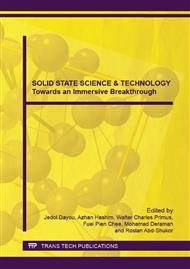p.9
p.14
p.20
p.27
p.32
p.38
p.45
p.53
p.59
Influence of NiO Nanoparticles on Physical Properties of TiO2 Doped Magnesium Ultra-Phosphate Glass-Ceramics
Abstract:
Tuning the physical properties of inorganic glass-ceramics through controlled doping of magnetic nanoparticles is topically challenging. A series of glass-ceramic having chemical composition 75P2O5-17MgO-(3-x)TiO2-5Li2O with x = 0 to 3 mol% containing nickel oxide (NiO) nanoparticles (NPs) are prepared by melt quenching method (MQT) via heat treatment at 350 °C. The effect of NiO NPs on thermal and magnetization response are examined. X-Ray Diffraction (XRD) pattern confirm the amorphous nature of the samples. Differential Thermal Analysis (DTA) measurement shows the decrement of glass stability from 327°C to 295°C with the increase of titanium dioxide (TiO2) contents which are glass seem to be unstable. Significant increase in the magnetization is evidenced with the increase of NiO nanoparticles from 1.5 mol% to 2 mol%. The improved physical properties of these glass-ceramics suggest their usefulness in photo-electronic.
Info:
Periodical:
Pages:
32-37
Citation:
Online since:
June 2015
Authors:
Keywords:
Price:
Сopyright:
© 2015 Trans Tech Publications Ltd. All Rights Reserved
Share:
Citation:


